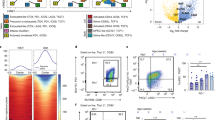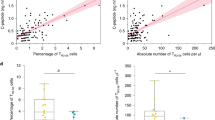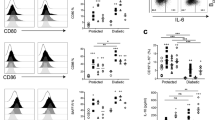Abstract
Autoantigens found on pancreatic islets can move to draining lymph nodes, where they are able to cause the activation and consequent deletion of autoreactive T cells by a mechanism termed cross-tolerance1,2. This deletion depends on signalling through CD95 (also known as Fas), a member of the superfamily of tumour-necrosis-factor receptors3. Here we describe a new mechanism that protects against autoimmunity: this mechanism involves another member of this superfamily, CD30, whose function was largely unknown. CD30-deficient islet-specific CD8-positive T cells are roughly 6,000-fold more autoaggressive than wild-type cells, with the transfer of as few as 160 CD30-deficient T cells leading to the complete destruction of pancreatic islets and the rapid onset of diabetes. We show that, in the absence of CD30 signalling, cells activated but not yet deleted by the CD95-dependent cross-tolerance mechanism gain the ability to proliferate extensively upon secondary encounter with antigen on parenchymal tissues, such as the pancreatic islets. Thus, CD30 signalling limits the proliferative potential of autoreactive CD8 effector T cells and protects the body against autoimmunity.
This is a preview of subscription content, access via your institution
Access options
Subscribe to this journal
Receive 51 print issues and online access
$199.00 per year
only $3.90 per issue
Buy this article
- Purchase on Springer Link
- Instant access to full article PDF
Prices may be subject to local taxes which are calculated during checkout



Similar content being viewed by others
References
Kurts, C., Kosaka, H., Carbone, F. R., Miller, J. F. A. P. & Heath, W. R. Class I-restricted cross-presentation of exogenous self antigens leads to deletion of autoreactive CD+ T cells. J. Exp. Med. 186, 239–245 (1997).
Heath, W. R., Kurts, C., Miller, J. F. A. P. & Carbone, F. R. Cross-tolerance: a pathway for inducing tolerance to peripheral tissue antigens. J. Exp. Med. 187, 1549–1553 (1998).
Kurts, C., Heath, W. R., Kosaka, H., Miller, J. F. A. P. & Carbone, F. R. The peripheral deletion of autoreactive CD8+ T cells induced by cross-presentation of self-antigens involves signalling through CD95 (Fas, Apo-1). J. Exp. Med. 188, 415–420 (1998).
Schwab, U. et al. Production of a monoclonal antibody specific for Hodgkin and Sternberg-Reed cells of Hodgkin's disease and a subset of normal lymphoid cells. Nature 299, 65–67 (1982).
Schwarting, R. et al. BER-H2: a new anti-Ki-1 (CD30) monoclonal antibody directed at a formol-resistant epitope. Blood 74, 1678–1689 (1989).
Bowen, M. A., Lee, R. K., Miragliotta, G., Nam, S. Y. & Podack, E. R. Structure and expression of murine CD30 and its role in cytokine production. J. Immunol. 156, 442–449 (1996).
Telford, W. G., Nam, S. Y., Podack, E. R. & Miller, R. A. CD30-regulated apoptosis in murine CD8 T cells after cessation of TCR signals. Cell. Immunol. 182, 125–136 (1997).
Gilfillan, M. C., Noel, P. J., Podack, E. R., Reiner, S. L. & Thompson, C. B. Expression of the costimulatory receptor CD30 is regulated by both CD28 and cytokines. J. Immunol. 160, 2180–2187 (1998).
Bowen, M. A., Olsen, K. J., Cheng, L., Avila, D. & Podack, E. R. Functional effects of CD30 on a large granular lymphoma cell line, YT. Inhibition of cytotoxicity, regulation of CD28 and IL-2R, and induction of homotypic aggregation. J. Immunol. 151, 5896–5906 (1993).
Lee, S. Y. et al. CD30/TNF receptor-associated factor interaction: NF-kappa B activation and binding specificity. Proc. Natl Acad. Sci. USA 93, 9699–9703 (1996).
Lee, S. Y., Park, C. G. & Choi, Y. Tcell receptor-dependent cell death of T cell hybridomas mediated by the CD30 cytoplasmic domain in association with tumor necrosis factor receptor-associated factors. J. Exp. Med. 183, 669–674 (1996).
Hamann, D. et al. CD30 expression does not discriminate between human Th1- and Th2-type T cells. J. Immunol. 156, 1387–1391 (1996).
Amakawa, R. et al. Impaired negative selection of T cells in Hodgkin's disease antigen CD30-deficient mice. Cell 84, 551–562 (1996).
Kurts, C. et al. Constitutive class I-restricted exogenous presentation of self antigens in vivo. J. Exp. Med. 184, 923–930 (1996).
Kurts, C. et al. CD4+ T cell help impairs CD8+ T cell deletion induced by cross-presentation of self-antigens and favors autoimmunity. J. Exp. Med. 186, 2057–2062 (1997).
Nikolic, Z. J. & Carbone, F. R. The effect of mutations in the MHC class I peptide binding groove on the cytotoxic T lymphocyte recognition of the Kb-restricted ovalbumin determinant. Eur. J. Immunol. 20, 2431–2437 (1990).
Mackay, C. R. Homing of naive, memory and effector lymphocytes. Curr. Opin. Immunol. 5, 423–427 (1993).
Duckett, C. S. & Thompson, C. B. CD30-dependent degradation of TRAF2: implications for negative regulation of TRAF signalling and the control of cell survival. Genes Dev. 11, 2810–2821 (1997).
Bevan, M. J. Cross-priming for a secondary cytotoxic response to minor H antigens with H-2 congenic cells which do not cross-react in the cytotoxic assay. J. Exp. Med. 143, 1283–1288 (1976).
Jondel, M., Schirmbeck, R. & Reimann, J. MHC class I-restricted CTL responses to exogenous antigens. Immunity 5, 295–302 (1996).
Vella, A. T., McCormack, J. E., Linsley, P. S., Kappler, J. W. & Marrack, P. Lipopolysaccharide interferes with the induction of peripheral T cell death. Immunity 2, 261–270 (1995).
Hogquist, K. A. et al. Tcell receptor antagonist peptides induce positive selection. Cell 76, 17–27 (1994).
Bertolino, P. et al. Peripheral deletion of autoreactive CD8+ T cells in transgenic mice expressing H-2Kb in the liver. Eur. J. Immunol. 25, 1932–1942 (1995).
Acknowledgements
We thank T. Mak for the CD30-deficient mice; J. Allison for advice; and T.Banjanin, F. Karamalis and P. Nathan for technical assistance. C.K. was supported in part by a fellowship from the Deutsche Forschungsgemeinschaft. This work was funded by the NIH, the National Health and Medical Research Council of Australia and the Australian Research Council.
Author information
Authors and Affiliations
Corresponding authors
Rights and permissions
About this article
Cite this article
Kurts, C., Carbone, F., Krummel, M. et al. Signalling through CD30 protects against autoimmune diabetes mediated by CD8 T cells. Nature 398, 341–344 (1999). https://doi.org/10.1038/18692
Received:
Accepted:
Issue Date:
DOI: https://doi.org/10.1038/18692
This article is cited by
-
Role of CD30 Targeting in Malignant Lymphoma
Current Treatment Options in Oncology (2014)
-
Optimized Surface Markers for the Prospective Isolation of High-Quality hiPSCs using Flow Cytometry Selection
Scientific Reports (2013)
-
CD30: from basic research to cancer therapy
Immunologic Research (2013)
-
Haplotype analysis of tumour necrosis factor receptor genes in 1p36: no evidence for association with systemic lupus erythematosus
European Journal of Human Genetics (2006)
-
Hodgkin’s Lymphoma and CD30 Signal Transduction
International Journal of Hematology (2003)
Comments
By submitting a comment you agree to abide by our Terms and Community Guidelines. If you find something abusive or that does not comply with our terms or guidelines please flag it as inappropriate.



